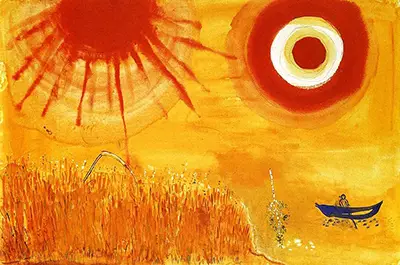A six year-long exile in America led to Chagall's first opportunity to become involved in the world of performance art, specifically ballet, and in 1942 the Ballet Theatre of New York (now called the American Ballet Theatre) commissioned the artist to design costumes and scenery for their production of Aleko. Based on a romantic poem by Pushkin named The Gypsies and Trio in A Minor by Tchaikovsky, the ballet was choreographed by Leonide Massine. Quite a large piece painted in gouache, watercolour and pencil on canvas and measuring 914.4 x 1524 cm, A Wheatfield on a Summer's Afternoon is Chagall’s backdrop for Scene III of the ballet, and in his own words, he sought to "penetrate Aleko without illustrating, without copying anything", he wanted "the colour to play and speak alone".
One of four backdrops that he painted for the ballet, A Wheatfield On A Summer's Afternoon marks a significant departure from the distinct Cubist works that Chagall is better known for. Intense swatches of singular colour are punctuated with a few prominent and symbolic elements, showing a great understanding from Chagall of the different medium for which he was creating. In a ballet, the main focus is always going to be on the dancers performing, and therefore the backdrop needs to be just that; in the background adding texture to the world rather than being the most eye-catching element of the production. The ballet tells a tragic story of a Russian youth who abandons his city life and goes on to fall in love with a gypsy girl to tragic consequences. This tale of passion, jealousy and tragedy is perfectly encapsulated by the bold choice of colour in Chagall's backdrop.
One might assume that deep yellows would evoke a sense of calm and freedom, but the presence of the large, looming fiery oranges in the skyline lend the backdrop an overwhelming sense of foreboding and danger that the narrative of the ballet moves towards in its tragic conclusion. Chagall completed this backdrop and the three others in Mexico City, and the ballet premiered there on September 8th, 1942. One month later, the production opened at the Metropolitan Opera House in New York, a city that was, and still is, arguably the most receptive to Chagall's signature blend of Eastern and Western influences, even in these works that are so distanced from his synonymous Cubist creations.

